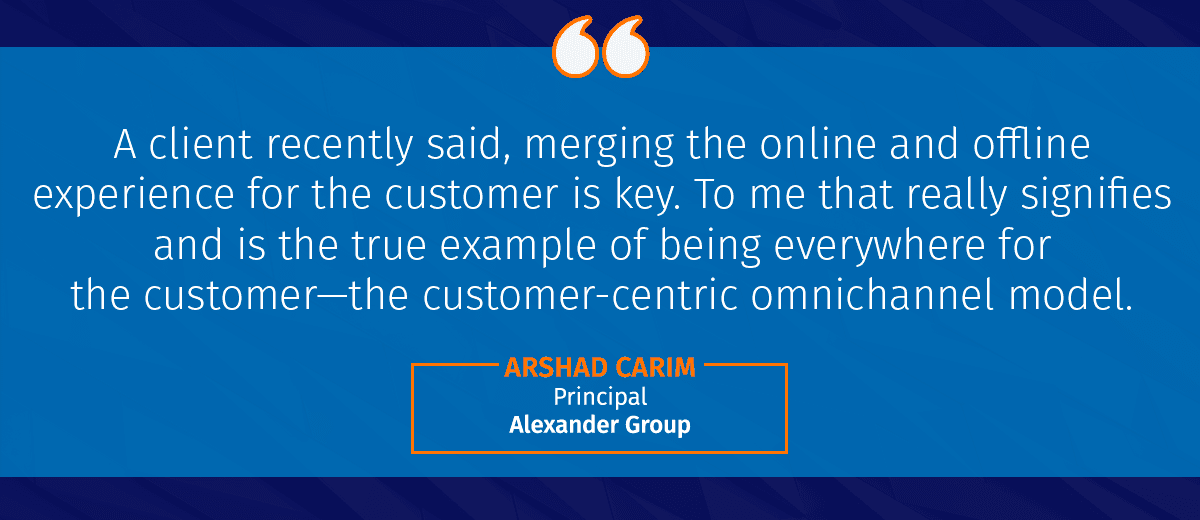The Digital Journey: Steps and Phases for Life Sciences

Steps that organizations use to focus on digital and customer process.
What are Life Sciences companies doing in relation to their digital journey? What investments are being made? How far along are leading firms in their “digital maturity”?
Alexander Group Principal and Life Sciences Practice Lead, Arshad Carim along with Sean Higgins, director at Alexander Group, recently discussed the steps and phases that organizations are going through as they focus on digital and how it relates to the customer purchasing process. Based on findings from Alexander Group’s recent Digital Study, Life Sciences and Analytical Instruments executives weighed in on how they define digital and where their firm stands within the digital maturity model.
Digital Maturity Model
Research suggests that companies typically go through four stages to develop their digital journey. Each stage is aligned with customer expectations, the transition from a reliance on physical channels to omnichannel availability—the seamless online/offline experience. Each stage of the digital maturity model includes different commercial activities across marketing, including e-commerce, sales and service. For example, e-commerce platforms are pushing Amazon-like experiences, “others who bought this buy this,” resulting in integrated workflows. This could include a lab director beginning their purchase experience via e-commerce on an online instrument configurator before asking for more personalization where they directly contact a sales rep to pick up where they left off. However, many organizations in Life Sciences have yet to implement systems that are this seamless, but they are trying to replicate the early success of retail and technology companies. Another example includes service organizations. Their digital roadmap includes an objective to evolve from a cost center to a profit center, transitioning from reactive call centers to gated self-service communities, and eventually, automation, where IoT is feeding proactive system triggers to conduct preventative maintenance. There are still some challenges to IoT in Life Sciences and what labs can really share with vendors. The collection of this data is very important not only for R&D and product but also for commercial organizations trying to use data science to be more prescriptive. This transition may be aspirational for some Life Sciences firms, but quite a few are pushing the edge.
Digital Roadmap: New Roles
When Life Sciences leaders think about the digital roadmap, they are focusing and positioning investments internally on the customer experience. Investing in digital is expensive, and leaders must prove the ROI of the investments. Focusing on customer experience shows that firms can actually make this profitable, and it creates a groundswell to keep the investment coming in. So what are they investing in?
Two new jobs have really come to the forefront in addition to one existing job that companies have prioritized over the past year. The first is an omnichannel experience manager, someone who owns the digital roadmap and brings the funding and digital vision to life. They actively monitor and assess the customer experience across multiple touchpoints, addressing gaps and future opportunities. The second is the omnichannel program manager who owns agile initiatives. They drive the execution and shoulder up with cross-functional stakeholders. Think of sales, marketing, I.T. and finance on projects that actively monitor the customer experience. But they also report on progress and KPIs and work very closely with the omnichannel experience manager. These roles span the entire buyer journey. Whether the customer is simply gathering information or are in a post-sales environment looking to gain specific information about an instrument or a set of consumables, the omnichannel roles are the crystallization point, those that run across marketing, sales and service continuum of the commercial model in the context and lens of the customer.
The third role that has been prioritized recently is the data scientist—those who work with I.T. to build and maintain data environments. They team with functional stakeholders to find high-impact applications for data and assets to power the predictive machine. Many organizations in the past have invested in data science, but they have yet to invest in the omnichannel experience manager and program manager, which can limit the success of the new online-offline experience.
Digital Roadmap: New Technology
Commercial leaders commonly cited three specific initiatives in their digital roadmap.
- Integrated Quoting: Enable customers to bounce on and offline when requesting a quote.
- Auto-Replenishment: Deliver innovative ordering experiences to existing customers and prioritize inventory by enabling customers to opt-in for automatic purchase of used consumables or scheduled service based on an observed use.
- Data Science Components: Think of the Amazon subscribe and save option with a monthly shipment that shows up with your paper towels each month. This method is very effective for reagents or consumables for life sciences.
The third initiative is immersive portals where companies nurture an inside-out relationship between themselves and their customers. These are places where customers can log on via their mobile device, PC, iPads or in the product itself and do just about everything from seeing their buying history, checking the status of orders, view pricing discounts and rebates, or access value-added content. And, most importantly, these platforms allow customers to engage with their sales and service team members. These portals are “gated communities” that host videos, FAQs and how-to guides. However, Life Sciences leaders have yet to see great returns in portal investments or an increase in customer self-service. It is clear that the portal is a necessity as it does add to the customer experience but may be a longer-term play for customer use.
What’s Next
Determining where your organization lies within the Digital Maturity Model is step one. For more information on how you can build out your digital roadmap, please contact an Alexander Group Life Sciences and Analytical Instruments practice lead.
_________________________________________________________
Not What You Were Looking For? Explore More…
Recommended Insights:
Article: Industry Trends Impacting Life Sciences & Analytical Instruments
Life Sciences and Analytical Instruments Industry Trends Study Briefing

